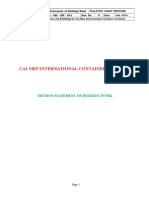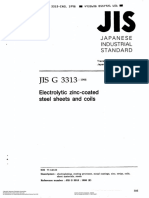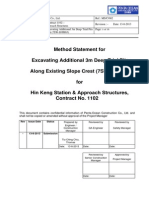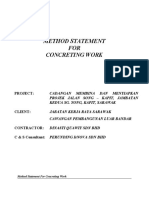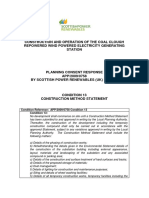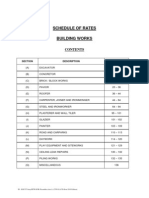Method Statement
Uploaded by
tsrao2938Method Statement
Uploaded by
tsrao2938Larsen & Toubro Limited Panipat Elevated Highway Project
ECC Division National Highways Authority of India
TABLE OF CONTENTS
DESCRIPTION PAGE
1. INTRODUCTION 2
2. ASSUMPTIONS 3
3. REFERENCE 4
4. SCOPE 5
5. MATERIALS 6
6. ELEVATED STRUCTURE 7
7. CONSTRUCTION METHODOLOGY 8
8. CURING 18
9. CONCLUSION 19
Method Statement for Construction of Elevated Structure Page 1 of 19
Larsen & Toubro Limited Panipat Elevated Highway Project
ECC Division National Highways Authority of India
1. INTRODUCTION
This method statement describes in brief the broad sequence and method of
construction of six lane elevated structure of length 3.6 km covering central
built up Panipat Section including Gohana road crossing, Sanauli road
crossing, bus stand and skylark tourist complex on BOT basis.
This Method Statement shall be read in conjunction with our construction
methodology drawings attached in Appendix A of this booklet.
Method Statement for Construction of Elevated Structure Page 2 of 19
Larsen & Toubro Limited Panipat Elevated Highway Project
ECC Division National Highways Authority of India
2. ASSUMPTIONS
Following assumptions have been made to arriving at this methodology:
Pier for elevated structure will be cast in single pour.
The safe Bearing Capacity of soil is considered as 10 t/Sqm for the
casting yard area.
The density of reinforced cement concrete considered as 2500 kg /
cu.m.
Method Statement for Construction of Elevated Structure Page 3 of 19
Larsen & Toubro Limited Panipat Elevated Highway Project
ECC Division National Highways Authority of India
3. REFERENCES
Following document has been referred for the preparation of this method
statement:
1. Technical Proposal – Appendix 5
Method Statement for Construction of Elevated Structure Page 4 of 19
Larsen & Toubro Limited Panipat Elevated Highway Project
ECC Division National Highways Authority of India
4. SCOPE
The scope of work includes the following major works:
• Construction of foundation [Bored cast in situ piles]
• Construction of Sub structure [Pier and Pier cap]
• Construction of Super structure [PSC I-Girder and Cast in situ slab]
Method Statement for Construction of Elevated Structure Page 5 of 19
Larsen & Toubro Limited Panipat Elevated Highway Project
ECC Division National Highways Authority of India
5. MATERIALS
5.1. Concrete: Concrete for the entire works will be supplied from captive
batching plants strategically located. Alternatively concrete will be
sourced from approved RMC plants. Materials used in the concrete will
be tested to check their conformity to project specification / standards.
Concrete will be transported from plant to the work place in transit
mixtures. Admixtures will be used with the prior approval of the engineer.
Temperature of the concrete will be maintained as per the specifications
/ standards.
5.2. Reinforcement: All reinforcement works will be done in centralised
reinforcement yard. Reinforcement will be stacked grade wise with
suitable identities. Bar bending schedules will be prepared based on
approved construction drawings and submitted for engineers’ approval.
All cutting and bending will be done as per approved bar bending
schedules. The reinforcement steel will be cleaned before use to remove
rust, oil, grease, salt and any other deleterious materials. Reinforcement
cages will be prefabricated to the extent possible to reduce the fixing
time at site. Required cover blocks will be provided as per specifications
/ standards.
Method Statement for Construction of Elevated Structure Page 6 of 19
Larsen & Toubro Limited Panipat Elevated Highway Project
ECC Division National Highways Authority of India
6. ELEVATED STRUCTURE
General and Structural Arrangement:
The Elevated Structure starts at a chainage Km 88+760 and ends at Km
91+819. The structure consists of continuous deck structure supported on
single column piers founded on pile foundations. The total length of structure
has been divided in to six segments as follows:
S.No Segment No. Chainage in m Total length in No. of Spans
m
1 Segment 1 88.560 to 89.060 500 9
2 Segment 2 89.060 to 89.550 490 17
3 Segment 3 89.060 to 90.089 539 17
4 Segment 4 90.089 to 90.570 481 15
5 Segment 5 90.570 to 90.900 330 11
6 Segment 6 90.900 to 92.240 1340 31
The deck of the structure is designed to cater for three lanes of traffic in each
direction with two separate decks. The carriageways are separated by
median of 1.2m in the elevated structure. The elevated structure comprises
multispan deck slab on precast pretensioned girders (span varies 27m to
31m) supported on single rectangular / square type piers and abutment twin
columns resting on pile foundations.
Method Statement for Construction of Elevated Structure Page 7 of 19
Larsen & Toubro Limited Panipat Elevated Highway Project
ECC Division National Highways Authority of India
7. CONSTRUCTION METHODOLOGY
7.1. Survey and Layout of Elevated structure:
The survey works for approaches will start with setting out of grids and
marking the existing ground features for the entire stretch of elevated
structure. Pier locations and bench marks for the regular survey will be fixed,
and the benchmarks will be cross-checked by closing the traverse and
ascertain the accuracy of bench marks. The survey pillars will be established
at convinent locations.
7.2. Soil Investigation:
Ground investigation if required will be carried out as per relevant codes. It is
proposed to deploy rotary type of drilling rigs for drilling the bores of 150mm
diameter using temporary casings.
The method of advancement and diameter of the bore will be such that the
boring will be completed and logged to the scheduled depth, and samples of
the specified materials will be obtained, in situ testing will be carried out as
required. In locations where water table is penetrated and disturbance of soil
is likely, positive hydraulic head will be maintained in the bore.
While the bore progresses, the sampling frequency and the type of samples
will be obtained as per the requirements. While drilling in the bore hole is in
progress the change in soil strata, colour of water, rate of penetration of the
drilling rod, starting and completion of each run, any water loss, side
collapsing etc. will be recorded and details furnished. All samples will contain
the full details of the location of bore, depth at which recovered etc. The
samples of soil collected from the bore hole will be packed in sealed packets
and sent to soil laboratory for tests.
Method Statement for Construction of Elevated Structure Page 8 of 19
Larsen & Toubro Limited Panipat Elevated Highway Project
ECC Division National Highways Authority of India
7.3. Site Infrastructure:
The site infrastructure will consist of project site offices and infrastructure
facilities for Precast I Girder casting, reinforcement yard and stacking. This
will contain temporary offices for the project managerial personnel, stores
and cement godown, work shop and generator shed etc. For layout of
casting yard and site facilities refer our drawing no O5086-Q-BR-CM-GA-
0008.
Casting Yard: The various components involved in the casting yard are listed
below:
Casting Bed for casting I-Girders.
Moulds for I-Girders
Gantries for handling PSC Girders from casting bed
Gantries for handling reinforcement cage and mould side shutters
Various rail tracks for handling & shifting the girders.
Based on the total number of girders to be casted and time duration
available, it is proposed to provide two numbers of casting beds. The casting
bed number: 1 will have provision for 8-girder casting and casting bed
number: 2 will have provision for 4-girder casting. Based on the length of
girders and Prestressing strand arrangement, the Type A girders will be cast
in bed number: 1 and Type B & C will be cast in bed number: 2. The casting
bed will have bulkhead provisions for stressing the strands before casting
and distressing the strands once the casting is completed.
Moulds for casting I-girders: - The I-girder mould will be fabricated out of
structural steel plates with sufficient stiffeners to resist the concrete pressure.
It is planned to deploy four bottom and two side shutters. The gantry
available in the yard can handle the side shutter from one mould to another.
Method Statement for Construction of Elevated Structure Page 9 of 19
Larsen & Toubro Limited Panipat Elevated Highway Project
ECC Division National Highways Authority of India
The PSC Girders will be cast in respective beds and once the casting is
completed, the strands will be distressed and the girders will be shifted to
stacking yard. The stacking of girders will be done in two tyres as shown in
our drawing O5086-Q-BR-CM-GA-0044.
The I-Girders from the stacking yard will be shifted to erection location by
long bedded trailers.
Method Statement for Construction of Elevated Structure Page 10 of 19
Larsen & Toubro Limited Panipat Elevated Highway Project
ECC Division National Highways Authority of India
7.4. Pile Foundation
All piling works for the foundation will comply with the requirement as per the
specifications for piling.
The pile points will be marked at specified locations, the hydraulic rotary
drilling rig (or) RTC rig is aligned to the exact location and the verticality of
the Kelly is checked. The temporary casing if required is driven along with
the advancement of pile boring. No permanent casing is envisaged. The
verticality of the temporary casing is then checked by spirit level while
lowering of bore and is recorded. The process of lowering the casing and
boring by auger is continued till the temporary liner reaches required level.
The verticality and the lateral shift of the pile are checked at regular intervals.
When the bore is intercepted with soft rock in the process of boring, the tool
bit will be changed from soil auger to rock auger/barrel for further boring
through soft rock. Once pile reaches the level as specified in drawing, the
boring is stopped and the bore is cleaned by bucket and sounding is
checked.
The pre-fabricated reinforcement cages in standard lengths will be cut for the
required length taking into account the bore depth, cut-off level, lap length
etc. Reinforcement cages are then welded together into the bore. Cover
blocks of suitable size will be tied to the reinforcement and lowered. Before
lowering the reinforcement cage the lap length and welds will be checked
and recorded.
Once the reinforcement cage is placed in position, tremmie pipes are
lowered up to the toe level and the bore is flushed properly. Content coming
out of the bore is checked for rock, sand and soil particles if any. Once the
bore is clear, the same will be approved by the Engineer. The concrete for
pile of the required grade and slump as per mix-design will be produced at
the batching plant and transported to site using transit mixers and placed by
suitable method. Through tremmie pipe the concrete will be allowed to
Method Statement for Construction of Elevated Structure Page 11 of 19
Larsen & Toubro Limited Panipat Elevated Highway Project
ECC Division National Highways Authority of India
overflow to at least 1m above the cut off level. The tremmie pipes and
temporary casing will be removed in stages as the concrete builds up in the
pile. The tremmie will be inside concrete by minimum 1.5m at all the times till
end of concrete.
The pile load test will be carried out at location specified by client.
Method Statement for Construction of Elevated Structure Page 12 of 19
Larsen & Toubro Limited Panipat Elevated Highway Project
ECC Division National Highways Authority of India
7.5. Pile Cap
Once all the piles at a pier location are completed, the reconnaissance
survey with the Engineer will be done and the pile cap layout will be
marked on the ground to commence the excavation work for pile caps.
Open excavation of slope 1:1 with a bottom working space of 0.6 m
maximum is considered. The excavation will be done using excavator up
to 100 mm above the binding concrete level. The dressing will be done
manually and the loose patches will be removed and compacted using a
hand hammer. The sides of the excavated pits will be protected using
shoring wherever required so as to prevent collapse and also to allow for
the movement of traffic in the adjoining area.
The pile heads will be chipped to the required level i.e. to the soffit level
of the pile cap and the blinding concrete will be placed. Reinforcement
from the pile will be bent to the required shape and the pile cap
reinforcement will be placed and tied along with starter bars for the pier.
The side forms / block work with solid blocks for the pile cap will be fixed
and checked for the edge co-ordinates and levels. After approval of the
engineer, concrete will be placed in position. In the mean time the starter
concrete for the pier will be cast on the top of the pile cap, which will be
used for casting the piers. The pile cap will be cured for 14 days. Back
filling of the pile cap will be done in layers and compacted using
excavated materials/ fill material as required in specification.
Method Statement for Construction of Elevated Structure Page 13 of 19
Larsen & Toubro Limited Panipat Elevated Highway Project
ECC Division National Highways Authority of India
7.6. Pier
Fixing of Reinforcement : After casting
the pile cap & starter for the pier, the
reinforcement for the pier shall be placed
& tied. All reinforcement will confirm to
the requirement of the specifications and
as shown in the approved drawings / bar
bending schedule. The prefabricated
renforcement cage will be kept in
position with the help of crane. The cage
will be aligned and firmly tied to the
dowels already left in starter with binding
wire.
Fixing of Formwork : The shutters for the pier will be fixed & aligned
depending on the height of pier. Inside surfaces of the forms will be coated
with approved release agent. The form work consists of shutters made of
steel plates and supported by
horizontal and vertical steel
walers. The vertical walers are
supported by inclined props for
alignment control and in turn
fixed to the anchor bolts
embedded in the pile cap.
Necessary working platform
and access ladders will also be provided. Refer our drawing ‘’ Pier Formwork
– General Arrangement‘’ (Drg. No. O5086-Q-BR-CM-GA-0054).
Method Statement for Construction of Elevated Structure Page 14 of 19
Larsen & Toubro Limited Panipat Elevated Highway Project
ECC Division National Highways Authority of India
Concreting of Pier : The concreting of pier will be done in single pour by
using boom placer or pump with Tremie / elephant trunk. The placing of
concrete will be carried out
such that segregation,
displacement of forms or
reinforcement are avoided.
The pier concrete will be
compacted using internal
vibrators to produce a dence
homogenous mass. If required windows will be provided in form work to
ensure proper compaction. Curing will be done as per the specifications for
required period of time.
Deshuttering : The side forms will be removed after concrete attains
sufficient strength. Care will be taken while removing the formwork such that
no damage is caused to the concrete and surface finishes.
Method Statement for Construction of Elevated Structure Page 15 of 19
Larsen & Toubro Limited Panipat Elevated Highway Project
ECC Division National Highways Authority of India
7.7. Erection of I-Girders
It is proposed to do the erection by using gantries. The stacked girders will
be transported by long bedded trailers from the stacking yard to erection
location. At the erection location the girders will be lifted from trailers and
placed in its location on pier by gantries. The necessary supporting brackets
for supporting the I Girders will be provided from the pier cap. The scheme
for I Girder erection using gantry is shown in our drawing no: O5086-Q-BR-
CM-GA-0101.
Method Statement for Construction of Elevated Structure Page 16 of 19
Larsen & Toubro Limited Panipat Elevated Highway Project
ECC Division National Highways Authority of India
7.8. Diaphragm & Deck Slab Casting
After completing the erection of girders in one span the formwork and
reinforcement for diaphragm will be placed and concreted. Precast planks
between the girders for deck slab will be placed. Reinforcement for deck will
be tied and concrete for slab will be placed by placer boom. For cantilever
deck, steel brackets will be fixed from the end-precast girders for supporting
the formwork and the concrete.
Method Statement for Construction of Elevated Structure Page 17 of 19
Larsen & Toubro Limited Panipat Elevated Highway Project
ECC Division National Highways Authority of India
8. CURING
Concrete will be cured by ponding on horizontal surfaces and by continuous
water sprinkling with nozzle for vertical surfaces. Water used for curing will be
free of any deleterious materials.
Method Statement for Construction of Elevated Structure Page 18 of 19
Larsen & Toubro Limited Panipat Elevated Highway Project
ECC Division National Highways Authority of India
9. CONCLUSION
The entire work will be
completed within the scheduled
time with excellent quality and
utmost safety using the
methodology setout in this
document by dedicated and
highly experienced team of
Engineers.
Method Statement for Construction of Elevated Structure Page 19 of 19
You might also like
- Method Statement Site Development - Excavation and FillNo ratings yetMethod Statement Site Development - Excavation and Fill12 pages
- Method Statement-Waterproofing System Substructure33% (3)Method Statement-Waterproofing System Substructure6 pages
- Method Statement For Excavating Additional 3m Deep Trial Pits (2013!08!13)0% (2)Method Statement For Excavating Additional 3m Deep Trial Pits (2013!08!13)16 pages
- Method Statement For A Construction Project92% (88)Method Statement For A Construction Project114 pages
- Method Statement For Demolition & Modification Works at Existing Retaining Wall RW580% (5)Method Statement For Demolition & Modification Works at Existing Retaining Wall RW547 pages
- 2.method Statement Excavation and Trenching100% (3)2.method Statement Excavation and Trenching4 pages
- Method Statement FOR Concreting Work: ProjectNo ratings yetMethod Statement FOR Concreting Work: Project6 pages
- Method Statement: Fabrication of Rebar Cages in CaissonNo ratings yetMethod Statement: Fabrication of Rebar Cages in Caisson3 pages
- Method Statement For Construction of Substructure Elements)100% (4)Method Statement For Construction of Substructure Elements)8 pages
- Example Method Statement For The Installation of Concrete Floor SlabsNo ratings yetExample Method Statement For The Installation of Concrete Floor Slabs8 pages
- Method Statement - Asphalt Road Rectification Completion Rev. 1No ratings yetMethod Statement - Asphalt Road Rectification Completion Rev. 17 pages
- 0 - BOQ For Security Upgrades and General REHABILITATION For The OFFICE Building OF UN RESIDENT COORDINATOR-1No ratings yet0 - BOQ For Security Upgrades and General REHABILITATION For The OFFICE Building OF UN RESIDENT COORDINATOR-150 pages
- Method Statement for Formwork, Reinforcement bars and Ready Mix Concrete عام50% (2)Method Statement for Formwork, Reinforcement bars and Ready Mix Concrete عام20 pages
- Method Statement For Concrete Works (Rev.01)67% (3)Method Statement For Concrete Works (Rev.01)12 pages
- Method Statement of Concreting Pile Cap Rev0275% (4)Method Statement of Concreting Pile Cap Rev023 pages
- Method Statement For Concrete Works: The Custodian of Two Holy Mosques King Abdullah Ibn Abdul-Aziz Project KAP5-Group 4100% (1)Method Statement For Concrete Works: The Custodian of Two Holy Mosques King Abdullah Ibn Abdul-Aziz Project KAP5-Group 441 pages
- SECTION 02221 Trench Excavating and Backfilling: Part 1 GeneralNo ratings yetSECTION 02221 Trench Excavating and Backfilling: Part 1 General4 pages
- Method Statement For Formworks, Rebars, Cast-In-Situ Concrete88% (16)Method Statement For Formworks, Rebars, Cast-In-Situ Concrete28 pages
- Besraya Eastern Extension: Method Statement FOR Pavement Construction100% (8)Besraya Eastern Extension: Method Statement FOR Pavement Construction16 pages
- Larsen & Toubro Limited - Ecc Division: Page 1 of 3100% (1)Larsen & Toubro Limited - Ecc Division: Page 1 of 33 pages
- Method_Statement_for_Construction_of_wildlife_underpass_R4-16Aug (1)No ratings yetMethod_Statement_for_Construction_of_wildlife_underpass_R4-16Aug (1)12 pages
- LNG PAR Modules of Ichthys LNG Project (April 2018) .... !!!!100% (1)LNG PAR Modules of Ichthys LNG Project (April 2018) .... !!!!5 pages
- D&Dwg of Approach Road of HRT PKG - Zero Point to Adit-1No ratings yetD&Dwg of Approach Road of HRT PKG - Zero Point to Adit-125 pages
- Master Specification - Part Rd-Ew-C3 - BoringNo ratings yetMaster Specification - Part Rd-Ew-C3 - Boring5 pages
- Project Standard Specification: Duct Insulation 15081 - Page 1/11No ratings yetProject Standard Specification: Duct Insulation 15081 - Page 1/1111 pages
- Soft CL S-sc534-1106 Seat Cover Ada Compliant Toto UsaNo ratings yetSoft CL S-sc534-1106 Seat Cover Ada Compliant Toto Usa1 page
- John W. Kurpeski - Consulting Engineer, P.E. Derek B. Mccowan - Associate Principal, P.ENo ratings yetJohn W. Kurpeski - Consulting Engineer, P.E. Derek B. Mccowan - Associate Principal, P.E50 pages
- Low Temperature Impact Strength of Heavy Section DNo ratings yetLow Temperature Impact Strength of Heavy Section D9 pages
- Anti-Scald Valves Using Shape Memory Alloys: Swati Bansal 18108048No ratings yetAnti-Scald Valves Using Shape Memory Alloys: Swati Bansal 1810804813 pages
- Average Cost of Septic Tank Construction Philippines - PHILCON PRICESNo ratings yetAverage Cost of Septic Tank Construction Philippines - PHILCON PRICES3 pages
- Exp.1 Carpentry and Pattern Making, Moulding, CastingNo ratings yetExp.1 Carpentry and Pattern Making, Moulding, Casting2 pages
- Method Statement Site Development - Excavation and FillMethod Statement Site Development - Excavation and Fill
- Method Statement-Waterproofing System SubstructureMethod Statement-Waterproofing System Substructure
- Method Statement For Excavating Additional 3m Deep Trial Pits (2013!08!13)Method Statement For Excavating Additional 3m Deep Trial Pits (2013!08!13)
- Method Statement For Demolition & Modification Works at Existing Retaining Wall RW5Method Statement For Demolition & Modification Works at Existing Retaining Wall RW5
- Method Statement: Fabrication of Rebar Cages in CaissonMethod Statement: Fabrication of Rebar Cages in Caisson
- Method Statement For Construction of Substructure Elements)Method Statement For Construction of Substructure Elements)
- Example Method Statement For The Installation of Concrete Floor SlabsExample Method Statement For The Installation of Concrete Floor Slabs
- Method Statement - Asphalt Road Rectification Completion Rev. 1Method Statement - Asphalt Road Rectification Completion Rev. 1
- 0 - BOQ For Security Upgrades and General REHABILITATION For The OFFICE Building OF UN RESIDENT COORDINATOR-10 - BOQ For Security Upgrades and General REHABILITATION For The OFFICE Building OF UN RESIDENT COORDINATOR-1
- Method Statement for Formwork, Reinforcement bars and Ready Mix Concrete عامMethod Statement for Formwork, Reinforcement bars and Ready Mix Concrete عام
- Method Statement For Concrete Works: The Custodian of Two Holy Mosques King Abdullah Ibn Abdul-Aziz Project KAP5-Group 4Method Statement For Concrete Works: The Custodian of Two Holy Mosques King Abdullah Ibn Abdul-Aziz Project KAP5-Group 4
- SECTION 02221 Trench Excavating and Backfilling: Part 1 GeneralSECTION 02221 Trench Excavating and Backfilling: Part 1 General
- Method Statement For Formworks, Rebars, Cast-In-Situ ConcreteMethod Statement For Formworks, Rebars, Cast-In-Situ Concrete
- Besraya Eastern Extension: Method Statement FOR Pavement ConstructionBesraya Eastern Extension: Method Statement FOR Pavement Construction
- Larsen & Toubro Limited - Ecc Division: Page 1 of 3Larsen & Toubro Limited - Ecc Division: Page 1 of 3
- Method_Statement_for_Construction_of_wildlife_underpass_R4-16Aug (1)Method_Statement_for_Construction_of_wildlife_underpass_R4-16Aug (1)
- LNG PAR Modules of Ichthys LNG Project (April 2018) .... !!!!LNG PAR Modules of Ichthys LNG Project (April 2018) .... !!!!
- D&Dwg of Approach Road of HRT PKG - Zero Point to Adit-1D&Dwg of Approach Road of HRT PKG - Zero Point to Adit-1
- Project Standard Specification: Duct Insulation 15081 - Page 1/11Project Standard Specification: Duct Insulation 15081 - Page 1/11
- Soft CL S-sc534-1106 Seat Cover Ada Compliant Toto UsaSoft CL S-sc534-1106 Seat Cover Ada Compliant Toto Usa
- John W. Kurpeski - Consulting Engineer, P.E. Derek B. Mccowan - Associate Principal, P.EJohn W. Kurpeski - Consulting Engineer, P.E. Derek B. Mccowan - Associate Principal, P.E
- Low Temperature Impact Strength of Heavy Section DLow Temperature Impact Strength of Heavy Section D
- Anti-Scald Valves Using Shape Memory Alloys: Swati Bansal 18108048Anti-Scald Valves Using Shape Memory Alloys: Swati Bansal 18108048
- Average Cost of Septic Tank Construction Philippines - PHILCON PRICESAverage Cost of Septic Tank Construction Philippines - PHILCON PRICES
- Exp.1 Carpentry and Pattern Making, Moulding, CastingExp.1 Carpentry and Pattern Making, Moulding, Casting
